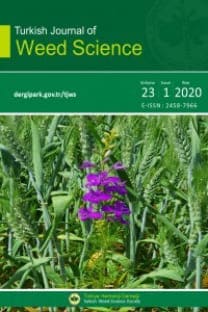ŞEKER PANCARI EKİM ALANLARINDA GÖRÜLEN KÜSKÜT (CUSCUTA CAMPESTRIS YUNCK.)’ÜN TANIMI, ZARARI VE YAYGINLIK DURUMU
Cuscuta genusu Cuscutaceae familyasında yer alan tam parazit bir bitkiler topluluğudur. Ülkemizde cinsaçı, verem otu, maraz, sarıot, sarmaşık, keçi sakalı, küsküt, gelinsaçı, küşüt ve şeytansaçı gibi isimleri ile tanınırlar. Bitki turuncu-sarımsı renkli, ipliksi ve yapraksız gövdelidir. Çiçekler 2-3 mm boyunda, pedisel (çiçek sapı), çiçek boyundan kısa, çiçekler kompakt çiçek topluluklarında toplanmıştır. Parazit bitki tohumları konukçusu olmadan gerekli sıcaklık ve nemi bulduğunda çimlenir. Gövdenin konukçuya bakan yüzeyinden parazit, konukçusuna emeçlerini uzatır ve bu emeçler konukçusunun floem ve ksilem ile bağlantı kurar. Böylece konukçusundan yaşamı için gerekli su, organik ve inorganik maddeleri alır. Yüksek oranda besin ve su depo eden bu parazit bitkiler son dönemlerinde konukçularına fazla bağımlı olmadan da yaşamlarını sürdürebilirler. Bir küsküt bitkisi 3.000-25.000 adet tohum verir. Tam parazit yabancı otlardan olan küsküt şeker pancarı verimini 3,5-4 ton/ha azaltmaktadır. Birçok araştırmada Cuscuta campestris Yunck.’in şeker pancarı tohum veriminde %63, şeker içeriğinde ise %18.7-55.4 oranlarında azalışa neden olduğu belirlenmiştir. Birçok ülkede istilacı tam parazit yabancı ot olarak kabul edilen ve orjini ABD olan C. campestris'in en yaygın olduğu kültür bitkisinin şeker pancar olduğu saptanmıştır. Türkiye’de en fazla ekimin yapıldığı Orta Anadolu’da yapılan çalışmalarda şeker pancarı ekim alanlarının %25-49’unda C. campestris’in yanında C. europaea, C. epythmum türlerinin de yaygın olduğu saptanmıştır. Türkiye şeker pancarı üretimi bakımından önemli bir yere sahip olan Tokat Merkez ve ilçelerinde yapılan sürveylerde ise çerçeve sayısına göre bulaşıklık oranı %32-36 arasında değişmiş, bulaşıklık en fazla Pazar ilçesinde görülmüştür. Tarla sayısına göre bulaşıklık oranı ise en yoğun olan ilçe %72,7' lik oranla Turhal ilçesi olarak belirlenmiştir. İstilacı tür olarak belirlenen bu parazit bitkiye karşı yeni mücadele yöntemleri geliştirilmediği takdirde büyük verim kayıpları olacaktır
INTRODUCTION, DAMAGES AND PREVALENCE STATUS OF CUSCUTA
(CUSCUTA CAMPESTRIS YUNCK.) FOUND ON SUGAR BEET CULTIVATED
AREAS
Cuscuta genus, located in the Cuscutaceae family is a plant community full of parasites. The genus is locally known by different names like cinsaçı, verem otu, maraz, sarıot, sarmaşık, keçi sakalı, küsküt, gelinsaçı, küşüt and şeytansaçı in Turkey. The plant is orange-yellowish in color, thready and having leafless stems. The flowers are 2-3 mm long, pedicelate (flower stalk), flowers are short and are gathered in compact communities. The seeds of parasitic plant germinate when find necessary temperature and humidity without the presence of host. The body of the parasitic plant facing towards host produces the vines and these vines form association with the xylem and phloem of the host. By this way the plant gets the organic and inorganic nutrients required for living from the host. These parasitic plants store water and nutrients in high quantities, and at later stages can continue surviving without getting dependent on host. One Cuscuta plant produces 3.00025.000 seeds. Cuscuta is among completely parasitic weeds and reduces sugar beet yield up to 3.5-4 tons ha-1. There are number of studies indicating that Cuscuta campestris Yunck decreases the sugar beet seed yield and sugar contents upt0 63% and 18.7-55.4% respectively. C. campestris originating from America has been recognized as invasive parasitic weeds in many countries and mostly invades sugarbeet crop. In Turkey, the sugar beet is widely cultivated in Central Anatolia region. In this region the prevalence of C. campestris has been recorded 25-49%. Additionally, C. europaea, C. epythmum species has also been widely found in the region. Tokat Province has an important place in terms of sugar beet production in Turkey. The surveys conducted in Tokat and its different districts indicated that the C. campestris infestation varied from 32-36% (in terms of number of quadrates) while the most infested district was found to be Pazar. According to the number of fields infested; Turhal district was found to be most infested with 72.7% infestation. If management practices are not improved against this invasive parasitic weed; severe yield losses are expected to happen in the future
